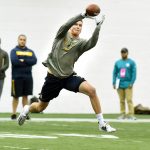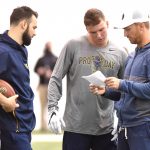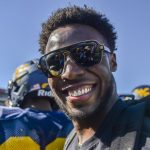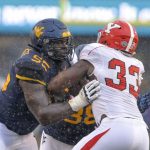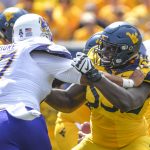Sizing up the NFL profiles of West Virginia’s draft-eligible players:
Will Grier
Will Grier is among the most productive quarterbacks in West Virginia history with just two seasons as a starter. He ranks third in program history with 7,354 passing yards and second with 71 touchdown passes. Grier finished fourth in the 2018 Heisman Trophy vote, the best showing for a Mountaineer since Steve Slaton in 2006.
Grier transferred to West Virginia from Florida, where he started five games as a redshirt freshman before his suspension for testing positive for an over-the-counter performance-enhancing substance.Feeling unwelcomed by then-Gators coach Jim McElwain, he came to WVU and sat out a year due to NCAA transfer rules.
Grier’s throwing velocity of 59 mph at the NFL combine tied Boise State’s Brett Rypien for the fastest mark in this year’s class.
Yodny Cajuste
A raw recruit who became a three-year starter at left tackle, Cajuste may be the first Mountaineer off the board after Grier. He measured 6-foot-5 and 312 pounds, with 34-inch arms.
Cajuste was bedeviled by foot and knee injuries early in his career, missing most of the 2015 and 2016 seasons. With that in mind, it came as little surprise when Cajuste elected to sit out last December’s Camping World Bowl to focus on the draft.
Injury concerns limited Cajuste from performing drills at the combine or pro day, though he did put up 32 reps in the bench press.
NFL Network analyst and former Redskins GM Charley Casserly is bullish on Cajuste.
“As a run-blocker, he’s a physical guy. He’ll punch you in the mouth,” Casserly said. “To me, he’s a second-round pick. If he doesn’t work out at tackle, you can try him at guard.”
David Sills
His story is becoming as well-known as that of Paul Bunyan. Offered a scholarship to play quarterback at USC when he was just 13 years old, Sills ended up at West Virginia and moved to receiver.
After a year at junior college to give quarterback another shot, he returned to the Mountaineers and became one of the most productive wideouts in program history.
A two-time all-American, Sills was a Biletnikoff finalist his junior year. His 35 career touchdown catches rank second in school history behind Stedman Bailey’s 41.
Sills had the eighth-best time among receivers at the combine in the 3-cone drill (6.97 seconds). He ran a 4.57 in the 40 and had a 37.5-inch vertical jump.
While lacking top-end speed and featuring a slender frame, Sills possesses supreme ball skills and projects to go in Rounds 4 or 5.
Gary Jennings
Recruited by Notre Dame to play defensive back, Jennings believed in his future as a receiver and chose West Virginia.
That decision has paid dividends ever since.
Jennings is sixth on the Mountaineers’ all-time list with 2,294 receiving yards. As a junior, he had the strange distinction of scoring just one touchdown on 97 catches.
He found the end zone 13 times as a senior, including an iconic last-minute grab that factored heavily into West Virginia’s 42-41 win at Texas.
Jennings had one of the better overall performances at the NFL combine among receivers. He ran a 4.42 in the 40, completed the 20-yard cone drill in 4.15 seconds, and did 20 reps in the bench press. Jennings also graded as one of the fastest players at the Senior Bowl despite being a late invite to the event.
He projects as a a third- to fifth-round choice.
David Long
Undersized, the Big 12 defensive player of the year might have been forced to change positions — or take his career to Canada — if he was entering the draft just a decade ago.
Instead, the 5-foot-10, 223-pound linebacker is blessed with the speed necessary to play his position in a more pass-happy era.
Long finished his redshirt junior season with 111 tackles, including 19 tackles for loss and eight sacks. He was a three-year starter.
Long sprained his ankle at the Senior Bowl and did not run at the combine or WVU’s pro day. That may cost him in the draft, but one scout likes him more than presumed first-rounder Devin Bush of Michigan.
“Personally, I would rather have David Long over Devin Bush for a round or two discount,” one league executive told NFL.com. “They have about the same size but Long is more productive and maybe less prone to injury.”
Trevon Wesco
A Martinsburg native who attended Musselman High, Wesco has drawn NFL attention thanks to a breakthrough senior season.
He had to start his career in junior college at Lackawanna before getting noticed by the Mountaineers. [Even then, WVU almost missed out by accidentally forgetting to offer Wesco a scholarship.]
Wesco made only one catch each of his first two years in Morgantown before becoming the most targeted WVU tight end in decades, finishing with 26 catches for 366 yards in 2018.
Wesco worked as a fullback and tight end at the Senior Bowl. At the combine, he led all tight ends with 24 bench press reps but posted a 4.89 time in the 40. Scouts came away impressed with his hands after pro day.
A team looking for a blocking tight end with a chance to blossom could be well-served to use a late-round pick on Wesco.



